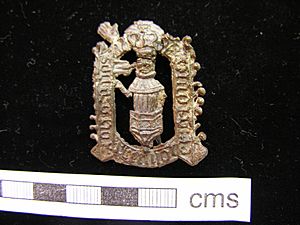Richard Caister facts for kids
Richard Caister was an English priest and poet who lived a long time ago, in the late 1300s and early 1400s. He was a spiritual guide, called a confessor, for a famous English mystic named Margery Kempe. After he passed away in 1420, his burial spot in Norwich became a special place where people would travel to pray.
Contents
Richard Caister's Early Life
Richard Caister was born in the mid-1300s. We don't know the exact year he was born. He might have been born in Caistor St Edmund or Caister-on-Sea, both places in England.
His Life as a Priest
In 1385, Richard Caister joined Merton Priory in Surrey. This is where he studied to become a priest. After he became a priest, he likely spent about ten years working as a monk at Norwich Cathedral Priory.
From 1397 to 1402, he was the Vicar (a type of priest) at St Mary's Church in Sedgeford. Then, from 1402 until he died in 1420, he was the Vicar of St Stephen's Church, Norwich.
Richard Caister and Margery Kempe
While he was the Vicar at St Stephen's, Caister became the confessor for Margery Kempe. A confessor is someone a person talks to about their spiritual life and problems. Margery Kempe wrote about him many times in her book, The Book of Margery Kempe.
She wrote that Christ told her to go to St Stephen's and ask Caister to be her confessor. Caister even stood up for Kempe when she was questioned by the Bishop of Norwich, Henry le Despenser.
His Poetry
Richard Caister wrote a hymn, which is a religious song or poem. It is called Jesu, Lord thou madest me. Someone even wrote music for this hymn.
This hymn was written in English. Another famous writer from Norwich, Julian of Norwich, also wrote in English around the same time. She was Caister's neighbor.
A scholar named John Pits later said that Caister also wrote other works. These included writings about the Ten Commandments and meditations by Saint Bernard. However, these writings are now lost.
Why People Remembered Him
Richard Caister was buried in the main part of St Stephen's Church. His burial place became a very important spot for people to visit and pray during the 1400s. This is called a pilgrimage site.
Margery Kempe wrote that even when Caister was alive, he was seen as a "holy man." She said that God showed he was holy through miracles. After Caister died, Kempe went to St Stephen's to pray for a sick priest. The priest got better, and this likely helped make Caister's burial place a popular pilgrimage site.
John Pits also wrote that Caister was known for many miracles, both when he was alive and after he died. St Stephen's Church was rebuilt in the 1500s. Because of this, Caister's burial place is no longer marked.
Pilgrim Badges
Many special pilgrim badges made to honor Caister still exist today. You can find examples of these badges in museums like the British Museum, the Museum of London, and the Lynn Museum.
His Legacy Today
For a while, Richard Caister was almost forgotten. But in 2020, people remembered him again for the 600th anniversary of his death. St Stephen's Church held a special "Richard Caister Project." This project celebrated his life and what he left behind. It included talks and lectures about Caister and related topics.


